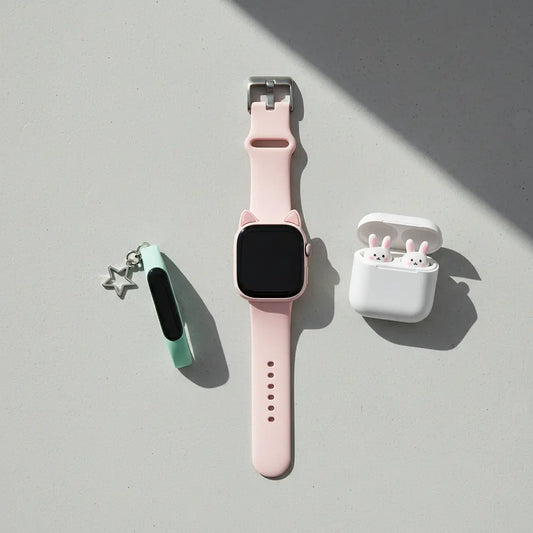
Beginner’s Guide to Custom Animatronic Cosplay Ears
Beginner’s Guide to Custom Animatronic Cosplay Ears
Ever wished your cosplay ears could actually move, twitch, or glow with vibrant color? You've seen them at conventions, those captivating, expressive ears that bring a character to life, and wondered if you could ever have a pair yourself. The good news is you don’t need to be an engineer to make that happen. This guide will show you how to step into the exciting world of animatronics, no matter your skill level.
Standing at your first convention can feel like leveling up in a massive multiplayer game. You’re surrounded by incredible characters, but you want your own cosplay to feel just as alive. That’s where the magic of custom animatronic ears comes in, transforming a static costume into something dynamic and expressive. They are the ultimate upgrade for any creator looking to add a layer of performance and interactivity to their work.

But the idea of "animatronics" can sound intimidating. You might be worried about complex tech jargon, the risk of wasting money on low-quality products, or simply not knowing where to begin. The fear of the unknown can often be the biggest barrier to entry, but it's a barrier we're about to break down completely.
Think of this article as your friendly blueprint. We will demystify the technology, show you affordable and beginner-friendly options, and give you a clear, safe path from initial curiosity to your very first pair of amazing, moving ears. By the end, you'll feel empowered and ready to make a choice that fits your character, budget, and creative vision.
What Are Custom Animatronic Ears?
Ever see a cosplayer whose ears twitch in response to a sound and wonder, "How did they do that?" This section breaks down the magic into simple, understandable concepts, showing you the different types of animatronic ears available today.
Custom animatronic ears are wearable accessories that use small motors and electronics to create lifelike movements. Unlike static ears attached to a headband, these robotic cosplay accessories can twitch, rotate, or fold down based on user input or automated programs. They bring a character to life in a way that static props simply can't.
Think of them like tiny, wearable puppets controlled by simple electronics. They add a layer of performance and personality to your cosplay, making your character feel more authentic and interactive. For example, a surprised twitch or a sad droop can communicate emotion instantly, creating memorable interactions with photographers and fellow fans.
The Different Types of Animatronic Ears
Not all animatronic ears are the same. They fall into a few main categories, each offering a different level of interaction and visual flair. Understanding these types is the first step in choosing the right pair for your cosplay goals.
- Movement-Based Ears: These are the most common type. They use small motors (called servos) to create motion. This can range from a simple back-and-forth twitch to complex, multi-axis rotations. They are perfect for bringing animal-like characters such as kitsune or werewolves to life.
- LED Light-Up Ears: Some models incorporate LED light-up animatronic ears that can change color. This feature is fantastic for futuristic or fantasy characters. Imagine ears that glow red when your character is angry or cycle through a rainbow pattern for a magical effect.
- Sensor-Based Ears: The most advanced cosplay ears use sensors to react to the environment. Motion-activated ears might twitch when you turn your head quickly. Others might react to sound, brainwaves (via an external EEG headset), or even facial expressions for a truly immersive experience.
Why They’re a Top Cosplay Trend
Animatronics are no longer reserved for Hollywood movie sets. Reports from major 2024 conventions showed a significant rise in the popularity of electronic cosplay gadgets. Why? Accessibility. As the technology has become cheaper and more user-friendly, it has opened the door for cosplayers to add high-impact effects without needing an engineering degree.
For a character like Holo from Spice and Wolf, her expressive ears are central to her personality. A pair of personalized moving cosplay ears can capture that essence perfectly, making the costume instantly recognizable and far more engaging for anyone you interact with at a convention. For a deeper look into the tech behind this trend, our article "From Cute to Clever: What Are Moving Cat Ears?" offers a great starting point for understanding the core mechanisms. This trend isn't limited to ears; cosplayers are integrating animatronics into all parts of their costumes. If you're building a character with a tail, you'll be interested to see the crossover in technology and trends, as explained in our feature on why fox tails are trending from conventions to daily wear.
How Do Animatronic Cosplay Ears Work?
Feeling intimidated by the wires, motors, and tech-speak? Let’s pop the hood and see what’s inside. This section simplifies the core components, making the technology feel less like a mystery and more like a set of simple building blocks.
At their core, all animatronic cosplay ears operate on a few basic principles. Understanding these components will empower you to make an informed choice, whether you decide to build your own or buy a pre-made set. There’s no complex science degree required.

A common misconception is that you need to be a programmer to use them. For most beginner models, this is not true at all. The majority of wireless moving cosplay ears are designed to be plug-and-play, often controlled by a simple remote or a user-friendly smartphone app.
The Brains: Microcontrollers
Every pair of animatronic ears has a small "brain," which is a tiny circuit board called a microcontroller. This component receives signals—either from a remote control or a pre-set program—and tells the motors what to do. Think of it as the director of a play, giving cues to the actors.
The Muscle: Servo Motors
The movement itself comes from small motors called servos. A servo doesn't just spin endlessly like a fan motor; it can be told to move to a precise position and hold it. This is what allows the ears to twitch, pivot, or fold with control. A quality servo is quiet and smooth, while a cheap one can be noisy and jerky.
The Control: Wired vs. Wireless
How you command your ears is a key difference between models.
- Wired: The controller is physically connected to the ears via a wire that can be hidden under your wig or costume. This is often a more budget-friendly option and ensures a stable connection, but the wire can sometimes get in the way.
- Wireless: These use Bluetooth or a radio frequency (RF) remote. This gives you complete freedom of movement, which is a huge advantage at a crowded convention. A pro-tip for first-timers: the extra cost for wireless is almost always worth it for the convenience alone.
The Look: Customization Layers
Finally, the electronics are placed inside a custom shell that forms the visible ear. This is where personalization shines. You can choose the shape (cat, fox, wolf), the fur or fabric covering, and even add extras like piercings or paint details. This layered approach is how do animatronic cosplay ears work to create a unique final product.
Beginner-Friendly Options in 2025
Worried that getting started with animatronics will be too expensive or complicated? This section is for you. We’ll spotlight affordable and easy-to-use options that deliver that "wow" factor without breaking the bank or requiring technical skills.
The world of robotic cosplay accessories is more accessible than ever. You don’t need to spend a fortune or learn to code to get a great pair of moving ears. In 2025, manufacturers are focused on creating entry-level products that are both affordable and incredibly simple to use right out of the box.
Many entry-level wireless models now start well under the $100 mark, making them a practical choice for cosplayers on a budget. This price point puts them in the same range as a high-quality wig or a detailed prop, making them a justifiable expense for leveling up your costume.

Affordable Starter Kits
For those on a tighter budget, starter kits offer a fantastic entry point. These kits typically include the essential electronics—servos, a simple controller, and a battery pack—and a basic headband. You are then free to create and attach your own ear shells, giving you creative control without the technical headache.
Wireless Entry-Level Models
The most popular choice for beginners is a pre-assembled, wireless model. These are designed for immediate use. You simply put them on, turn them on, and control them with a small, discreet remote. Look for models that use a simple phone app for control. If you can use a social media app, you can operate these ears.
Consider the story of Alex, a first-time cosplayer getting ready for a 2025 convention. Feeling nervous, Alex invested in a simple wireless kit for their kitsune character. At the con, the ability to make the ears twitch in photos and react to friends made for an incredible icebreaker, completely transforming their experience.
Basic Color Customization
You don't need programmable robotic cosplay ears to get cool color effects. Many beginner-friendly models now include built-in LED light-up animatronic ears with simple controls. A button on the remote might cycle through a few pre-set colors or a simple pulsing effect, adding a vibrant, eye-catching dimension to your cosplay with zero programming needed.
Ready to see what’s out there? Choosing the right features is key to a great first experience. Our checklist makes it easy.
Download our starter checklist for first-time buyersWhich Ear Type is Right for You?
Answer this quick question to find your perfect match!
My top priority for my cosplay ears is...
DIY vs Ready-Made: Which Path to Take?
Should you build your ears from scratch or buy a professionally made pair? It’s a classic crafting dilemma. This section provides a clear breakdown of both paths, helping you decide which route best fits your budget, timeline, and creative spirit.
Choosing between a DIY project and a ready-made product is a major decision. One path offers deep satisfaction and ultimate customization, while the other provides convenience and guaranteed quality. There’s no single right answer—it all depends on your goals, skills, and the time you have before your next event.
| Feature | DIY Route | Ready-Made Route |
|---|---|---|
| Best For | Crafters who love a challenge and want total control. | Cosplayers who need a reliable product quickly. |
| Cost | Lower initial parts cost, but can increase with tools/mistakes. | Higher upfront cost, but predictable pricing. |
| Time Investment | High (Many hours/days). | Low (Ready to wear out of the box). |
| Customization | Unlimited. Perfect character matching is possible. | Limited to seller's options. |
| Biggest Pro | The pride and skill gained from building it yourself. | Guaranteed quality and convenience. |
The DIY Route: Pros and Cons
Building your own personalized moving cosplay ears can be an incredibly rewarding experience. It gives you complete control over every detail, from the exact shape of the ear to the nuance of its movement.
-
Pros:
- Ultimate Customization: You can perfectly match the ear shape, fur color, and movement patterns to your specific character.
- Lower Cost (Potentially): If you already own basic tools like a soldering iron or 3D printer, the component costs can be lower than a pre-made set.
- Valuable Skills: You’ll learn basic electronics and fabrication skills that you can apply to future cosplay projects.
-
Cons:
- Steep Learning Curve: If you're new to electronics, troubleshooting can be frustrating.
- Time-Consuming: A DIY build can take many hours, from printing and sanding parts to wiring and programming.
- Hidden Costs: A common misconception is that DIY is always cheaper. If you need to buy tools, filament, or multiple components due to mistakes, the costs can add up quickly.
The Ready-Made Route: Pros and Cons
Buying professionally made ears is the fastest and most reliable way to add animatronics to your cosplay. These are built by experienced makers, ensuring they are durable and function correctly right out of the box.
-
Pros:
- Convenience and Speed: They are ready to wear immediately. This is ideal if your convention is just a few weeks away.
- Guaranteed Quality: Reputable sellers test their products thoroughly, so you can trust they will work reliably through a long convention day.
- Polished Finish: Professional ears often have a more polished and durable finish than a first-time DIY project.
-
Cons:
- Higher Initial Cost: You are paying for the maker's expertise, labor, and time, so the upfront price is higher.
- Limited Customization: While many sellers offer color and shape options, you won't have the same level of granular control as a full DIY build.
The 2025 Trend: Hybrid Approaches
A growing trend is a hybrid approach. Many cosplayers buy a reliable electronic base kit and then 3D print or craft their own custom ear shells. This gives you the reliability of a professionally made electronic system with the creative freedom of a DIY project.
To help you weigh your options with even more detail, you need a resource that lays everything out side-by-side. For a complete breakdown with cost comparisons, difficulty levels, and real build examples, the definitive resource to consult is our DIY Personalized Moving Cosplay Ears Guide. It provides the in-depth analysis needed to make the best choice for your project.
Where to Buy & What to Watch Out For
You’re ready to make a purchase, but the internet is vast and full of potential traps. How do you find a quality product and avoid getting scammed? This section is your safety guide, pointing you toward trusted sellers and teaching you how to spot the red flags.
Knowing where to shop for custom animatronic ears is just as important as knowing what to look for. The right marketplace will connect you with skilled artisans and reliable products, while the wrong one could leave you with a broken accessory and an empty wallet.
Trusted Marketplaces and Stores
You don't have to search in obscure corners of the internet. High-quality electronic cosplay gadgets are often found in places where creators and fans gather.
- Etsy: This is the top destination for custom and artisan-made cosplay accessories. You can find dozens of creators offering unique designs, and the public review system helps you gauge a seller's reputation.
- Specialty Cosplay Tech Stores: Dedicated online shops that focus specifically on cosplay electronics are an excellent choice. They often provide better customer support and have a deeper understanding of what cosplayers need for conventions.
- Social Media Creators: Many talented makers sell directly through platforms like Instagram or Twitter. Look for creators who post frequent updates, work-in-progress photos, and videos of their products in action.
Red Flags for Low-Quality Products
As you browse, keep an eye out for warning signs. A common myth is that a super low price is a great deal; more often, it's a sign of a bad product.
- 🚩 Vague or Copied Descriptions: If a product listing has very little detail or uses generic, broken English, be cautious.
- 🚩 Stock Photos Only: A seller who only uses polished stock images or 3D renders without showing photos of the actual physical product is a major red flag.
- 🚩 No Videos of Movement: This is a critical one. Always look for a video demonstrating the ears in motion. Photos can't show you if the movement is smooth or jerky, or if the motors are loud and distracting. Smooth, quiet movement is a hallmark of quality.
- 🚩 Lack of Reviews or Bad Reviews: Check seller feedback carefully. A history of shipping delays, poor communication, or products breaking shortly after arrival are clear warnings to stay away.
Pro-Tips for First-Time Buyers
Before you click "buy," do one final check. Read the seller's return policy and shipping times carefully, especially if you have a convention deadline. Don't be afraid to message the seller with questions; a responsive and helpful creator is a good sign you're in safe hands.
To skip the guesswork and avoid the risks, the top choice for finding reliable, convention-ready models is our regularly updated guide. For a curated list of vetted products, the best resource is our Best Animatronic Cosplay Ears 2025: Top Ranked Picks.
Your Next Step into an Animated World
You've learned what custom animatronic ears are, demystified how do animatronic cosplay ears work, and explored the options available for every budget and skill level. The most important takeaway is that this exciting technology is no longer out of reach. It's an accessible and powerful tool for bringing your favorite characters to life.
Whether you choose a simple wireless pair for your first convention or decide to embark on a DIY animatronic ear kit 2025 project, you now have the knowledge to move forward with confidence. You understand the components, know what to look for in a quality product, and where to find trusted sellers. The barrier to entry has never been lower, and your creativity is the only limit.
Your journey into the world of interactive cosplay is just beginning. The next logical step is to explore the specific products that fit your needs. We highly recommend starting with our curated guide to the Best Animatronic Cosplay Ears 2025 to see top-rated options that we've vetted for quality and performance.
For more guides and product roundups delivered straight to your inbox, subscribe to our newsletter. And if you found this guide helpful, please share it with your fellow cosplay friends!
Frequently Asked Questions (FAQ)
Battery life varies depending on the model and how actively you use them, but a good quality pair should last between 4 to 8 hours on a single charge. This is typically enough to get you through the busiest part of a convention day. Most use rechargeable lithium-ion batteries and can be topped up with a standard USB power bank.
It is strongly advised not to. The electronic components, including the motors and circuit boards, are not waterproof. Light drizzle might not cause immediate damage if they are well-covered by a wig, but direct exposure to rain can short-circuit the electronics and cause permanent failure.
For beginners, it can be challenging. Programmable ears often use platforms like Arduino, which requires some basic coding knowledge. However, many makers are now creating user-friendly software or apps that allow for "code-free" programming, where you can create movement sequences on a simple visual timeline.
For a solid, entry-level, ready-made wireless pair, a good budget to start with is between $80 and $150. In this range, you can find reliable models with smooth movement and decent battery life. DIY kits can be cheaper in terms of parts (around $40-$70), but you must also factor in the cost of tools if you don't already own them.




